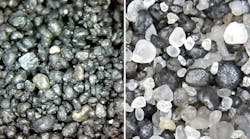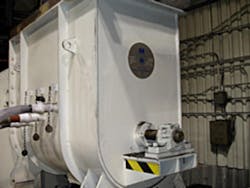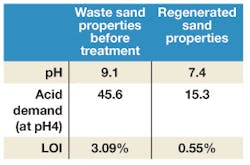Is it a liability or a resource? That’s the crux of the revolving discussion about sand in metalcasting operations, and despite the fact that this problem (or opportunity) is so widely recognized — different foundries must approach it differently because the job of handling foundry sand manifests itself differently from one foundry to the next.
Now, one company aims to reframe the matter around a new process technology, and if it succeeds it will be because it addresses both versions of the foundry sand conundrum — conserving the resource and reducing the liability. In the course of this outcome, it will establish a new, standard process function for green sand foundries.
Renotek International, Sherbrooke, Quebec, owns the North American license for the patented Renofont process, which it describes as a “bentonite and sand reclamation system” for green sand that conserves the value of the mold and core makeup materials, and reduces the significant responsibility for disposing of the otherwise spent sand.
Green sand is a general term for the various, specific combinations that foundries use to form molds (and cores), in order to hold a shape that will contain molten metal well enough to resist thermal shock effectively as the metal solidifies. The formulation of the green sand is critical to other aspects of the process too, like the surface finish of the cast product, and the mold’s ability to absorb gas emitted by the cooling metal. In general, green sand consists of 75-85% sand (silica, chromite, zircon, olivine, or graphite), 5-11% bentonite (clay), 2-4% water, 3-5% other inert material, and 0-1% carbon (e.g., anthracite, or “sea coal.”)
The specific formulations are determined by many factors, including the metal that is being poured, as well as the cost and availability of different sand types and the expense and/or difficulty of handling the spent sand. The cost of environmental compliance for handling (e.g., landfilling) the sand is part of this consideration.
Renotek aims to overturn all these calculations with its technology, which it emphasizes uses only water and very little energy to clean the spent sand, recovering both bentonite and sea coal. Pierre Boucher, director of finance and sales for Renotek, indicated the process was patented first in Europe, later in North America, and that the company has only recently started its marketing effort to foundries in the U.S. and Canada.
New Production Process Step
The process resulted from at least 15 years of inquiry by Albert Fontaine, now a foundry technical consultant, to arrive at a proper approach for cleaning sand without affecting the critical grain size (AFS designation), which would reduce or eliminate the ability to reuse the sand. (As a point of interest, the same process can be used to treat soils or mine residues, though that is not part of Renotek’s current focus.)
The process equipment is relatively simple, centered on a “Renofont reactor,” the vessel in which the sand cleaning activity is carried out. The reactor operates with water only, and consumes very little energy. All of the supporting tools and process equipment is generic, including screens, tanks, pumps and plumbing, conveyors, and a decantation system. Every installation is engineered according to the needs and space available for specific foundry customers.
Once installed the Renofont process becomes another stage in a foundry operation. Pre-screened, used sand is measured and conveyed to the Renofont reactor. A precise quantity of water is measured and injected into the reactor, and the system starts: used sands are dropped into the reactor. Once the reactor is activated, bentonite and sea coal are separated from the sand, and the automated system ejects bentonite and sea coal as a “slurry.” This material is available for returning to the make-up area for molding and core sand.
A particular advantage of using this “slurry” is that the bentonite component is already swelled, so that green sand will reach its full strength faster.
Next, more water is added to the sand remaining in the reactor. The system is reactivated for a final cleaning of the sand, as impurities (include ‘dead clay’) are evacuated with the water to a decanting station. There, the water is recycled to the system.
The remaining clean sand is ready to be screened to match the foundry’s AFS goal, and while a minimal volume of sand is rejected, clean sand is ready to return to the casting cycle. Water from this final screening is recycled, too.
The system is scalable to different foundries’ sand volumes, and for larger foundries adding a second reactor to the operation can increase the system volume. For even larger needs, more than one production line can be coordinated
Boucher noted that there is no chemical reaction in the process, which uses water exclusively as a cleaning agent. He noted the principle involves cleaning the sand so that active bentonite and sea coal are extracted into the slurry, which can be reused as the clay and carbon component of a new molding sand mixture.
Every Renotek installation is automated, but there is no specially defined software to learn, install, program, or update. As for process/quality control, the foundry’s sand lab can monitor and control the regenerated sand and bentonite concentrations using standard testing.
Scalable, Customizable
The process is fully scalable, Boucher reiterated, so there is no restriction to sand processing volumes, though each installation must be tested to determine the best process approach for different types of sand and binders. Each foundry completes a sand audit (available online at www.renotek-int.com) and then submits sand samples for testing. The results of those tests help to evaluate the specific needs for each foundry’s installation. “Every system is calibrated to the specific waste sand of the foundry,” Boucher indicated.
Reportedly, the Renofont process recovers 90-95% of used sands, the variability depending mostly on the rejected fines. The reactor does not affect the grains (AFS), according to the source, though sometimes the waste sand input contains a lot of fines that will be voluntarily screened out by the foundry at the end of the process.
As for bentonite and sea coal recovery rates, the types and volumes of these inputs varies from one foundry to an other, but Boucher affirmed that the recovery rates for each is more than 50%, and may be as high as 85%.
The process waste contains nothing that was not introduced to the reactor with the spent sand, because Renofont uses only water as a reactive agent. Any waste product from the reactor will be composed mainly of sand fine particles that the foundry does not want to reintroduce to its production, and other impurities like dead clay. The overall waste goes from 100% down to less than 10%, Boucher noted.
A single production line will treat one to 12 tons per hour. This volume can be increased as necessary by aligning additional process lines. Of course it becomes more profitable for larger installations, as the investment for the equipment around the reactors is more productive.
Each system is designed as a custom installation, planned in collaboration with the foundry and its suppliers. “Some might add equipment to dry the regenerated sand to use it for coremaking,” Boucher said. “Others might want to reintroduce the sand in the green sand molding line. With the increase in the price of sand, the profitability should increase overtime and the payback can be less than one year for the foundry.”
To date, there is one working Renofont installation at a foundry in Europe, with full customer satisfaction. The North American market is taking its first looks at the technology. Renotek noted it is testing sand for different foundries in preparation for proposals, and expects to install its first system soon.











